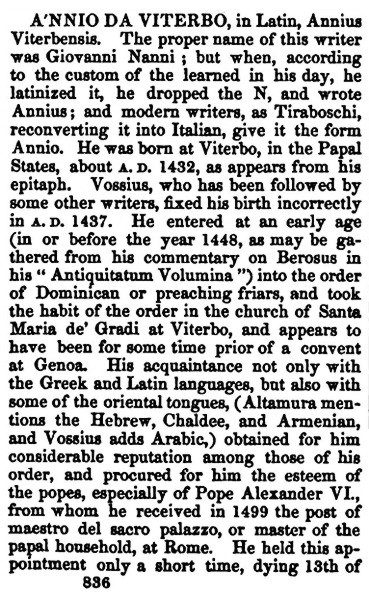Lessico
Annio da Viterbo
Giovanni o Nanni da Viterbo
Teologo e orientalista (Viterbo 1432 - Roma 1502). Religioso dell'ordine domenicano, fu maestro del Sacro Palazzo. La sua opera Antiquitatum variarum volumina XVII (1498) diede luogo a polemiche circa l'autenticità o meno di frammenti di antichi autori ivi raccolti.
Annio da Viterbo
Annio da Viterbo or Annius of Viterbo (c. 1432 – 13 November 1502), or Joannes Annius Viterb(i)ensis, was an Italian Dominican friar, scholar and historian, born Giovanni Nanni (Nenni) in Viterbo. He is now remembered for his fabrications.
He entered the Dominican Order early in life and won fame as a preacher and writer. He was highly esteemed by Sixtus IV and Alexander VI; the latter made him Master of the Sacred Palace. He was reputedly skilled in the Oriental languages. Walter Stephens, however, says: His expertise in Semitic philology, once celebrated even by otherwise sober ecclesiastical historians, was entirely fictive [...] - Annius also claimed to be able to read Etruscan.
He is best known for his "Antiquitatum Variarum", often known as The Antiquities of Annius. In this work he published alleged writings and fragments of several pre-Christian Greek and Latin profane authors, destined to throw an entirely new light on ancient history. He claimed to have discovered them at Mantua.
Among his numerous other writings may be mentioned "De futuris Christianorum triumphis in Turcos et Saracenos", a commentary on the Apocalypse, dedicated to Sixtus IV, to Christian kings, princes, and governments, and "Tractatus de imperio Turcorum". The author claims that Mohammad is the Antichrist, and that the end of the world will take place when the Christians will have overcome the Jews and the Muslims, which event did not appear to him to be far distant.
One influential suggestion he made was that the genealogy in the Gospel of Matthew applied to Joseph, while that in the Gospel of Luke was Mary's.
The more important of his unpublished works are: "Volumen libris septuaginta distinctum de antiquitatibus et gestis Etruscorum"; "De correctione typographica chronicorum"; "De dignitate officii Magistri Sacri Palatiiö, and lastly, his "Chronologia Nova", in which he undertakes to correct the anachronisms in the writings of Eusebius of Caesarea.
He was notorious for his text depicting the topography and ancient history of Rome, from the "most ancient" authors. His Auctores vetustissimi printed at Rome, 1498, was an anthology of seventeen purportedly classical texts, all of which he had written himself. Annio's map of Rome as founded by Romulus is a loose interpretation of one of his own forgeries. It prominently features "Vicus Tuscus," the home of the Etruscans whom Annio and his fellow Viterbans claimed as their ancestors. Part of the forgeries were motivated by a desire to prove that Viterbo was the site of the Etruscan Fanum Voltumnae.
In a defense of the papal lending institution, the Monte di Pietà, published c. 1495 under the title Pro Monte Pietatis, Annio contributed the essay Questiones duo disputatae super mutuo iudaico & civili & divino, arguing against the usury of the Jews.
The
Antiquities met at once both with believers, and severe critics who accused
him of willful interpolation, or even fabrication. The content was falsely
attributed to Berosus![]() ,
Fabius Pictor, Cato, Manetho and others. The spurious character of these
"historians" of Annio, which he published both with and without
commentaries, has long been admitted. The demolition of the forgeries owed
much to Joseph Justus Scaliger
,
Fabius Pictor, Cato, Manetho and others. The spurious character of these
"historians" of Annio, which he published both with and without
commentaries, has long been admitted. The demolition of the forgeries owed
much to Joseph Justus Scaliger![]() .
.
Annio's forgeries began to come unravelled by the mid-16th century. In 1565-66 the humanist Girolamo Mei was engaged in a historiographical argument with Vincenzo Borghini, who presented a claim, for the occasion of the marriage of Francesco I de' Medici and Giovanna of Austria, that Florence was founded by Augustus. He based his claim on inscriptions reported by Annio da Viterbo. Mei, no friend to the Medici, challenged this opinion and questioned the authenticity of Annio's materials, in a brief Latin treatise De origine urbis Florentiae (Shaked).
London - 1843

